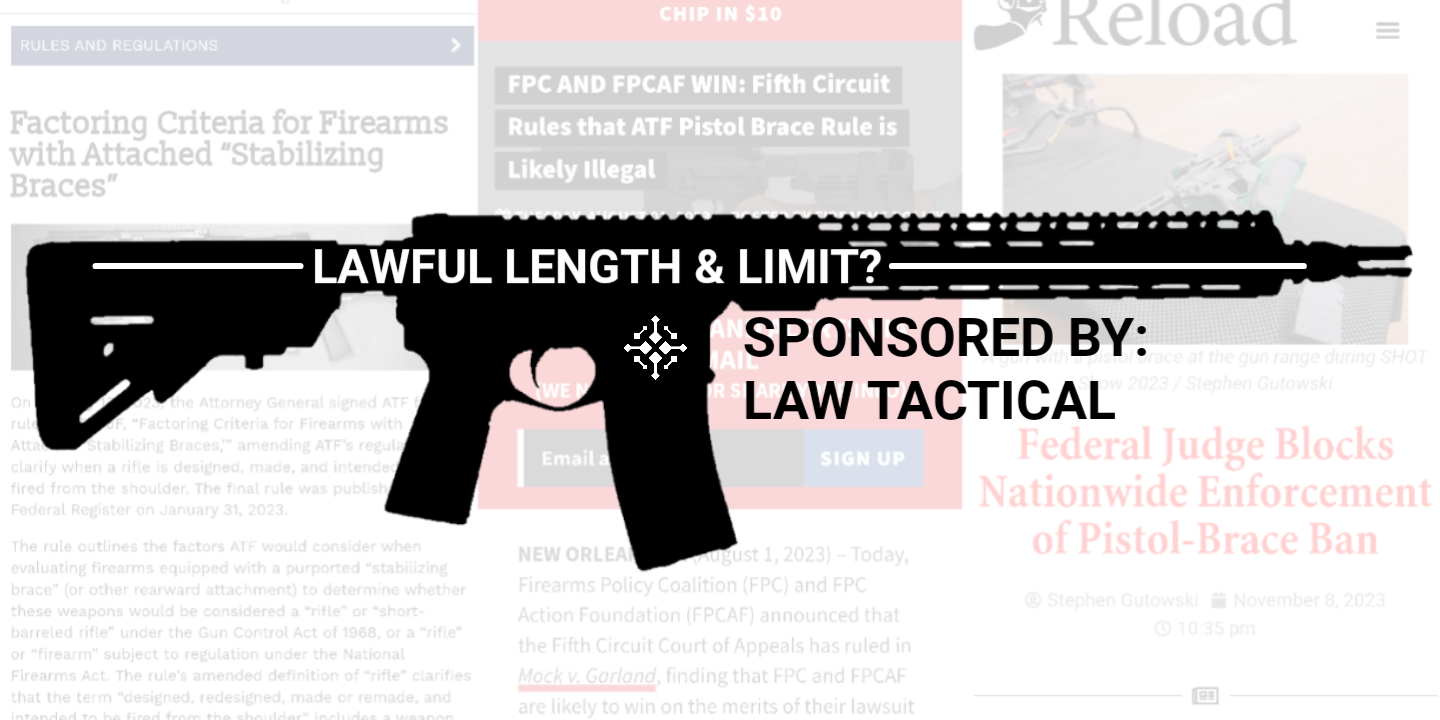LAWFUL LENGTH

Author: Frank Woods
Amidst all the drama surrounding pistol braces relative to NFA status as of late, it can be hard to determine what the legal boundaries are or which accessories affect them as it pertains to AR-15 Rifle length and configuration, understandably so. Many were swept up in the banning of pistol braces that treated them the same as a stock in the eyes of the NFA, and there was a lot of waffling whether to get rid of them, or register them for the “free” tax stamp (which wasn’t even really a stamp, but a conditional “approval” of sorts).
It’s so bad that I tried to speak to the FPC, the GOA, and the FRAC and ask all three of them if they could explain where things currently sit with braces, what with all the back and forth going on between the courts and the legislature. None of them would answer the question, all I got was a useless “the current regulations are what they are, no comment further” stonewall type of answer from them. Very helpful, thanks guys. Keep the fire.
So my friends at LAW Tactical came to me and said hey, it would be helpful if there was an outline to help folks determine in no uncertain terms what the legal parameters are for a rifle, for those wondering whether or not they’re in the clear or if LAW Tactical’s influence the legality of their configuration. So we got to talking and came up with this short guide to help you navigate your options while you’re surfing the Black Friday and Cyber Monday sales this holiday season.
?? ???????: We’re only concerning ourselves with “Rifles” and “Firearms” for the purpose of this document, not so much “Pistols.”
TO THE LETTER
Let’s get straight to it. Per the ATF NFA handbook: “The overall length of a firearm is the distance between the muzzle of the barrel and the rearmost portion of the weapon measured on a line parallel to the axis of the bore.”
Obviously if it’s got a stock and the barrel length (excluding the muzzle device if not pinned) is less than 16″, that makes it a short barreled rifle, but pinning a long enough muzzle device to a shorter barrel also counts towards the 16” minimum. We’re not only gonna focus on barrel length, but also overall length (OAL). In the case of the shortest legal Non-NFA rifles, the magic number is 26 inches.
NOTHING about the LAW Folding Stock Adapter or the ARIC BCG along with it affect the OAL measurement, and they have never been subject to anything related to the status of pistol braces in the eyes of the NFA regulations.
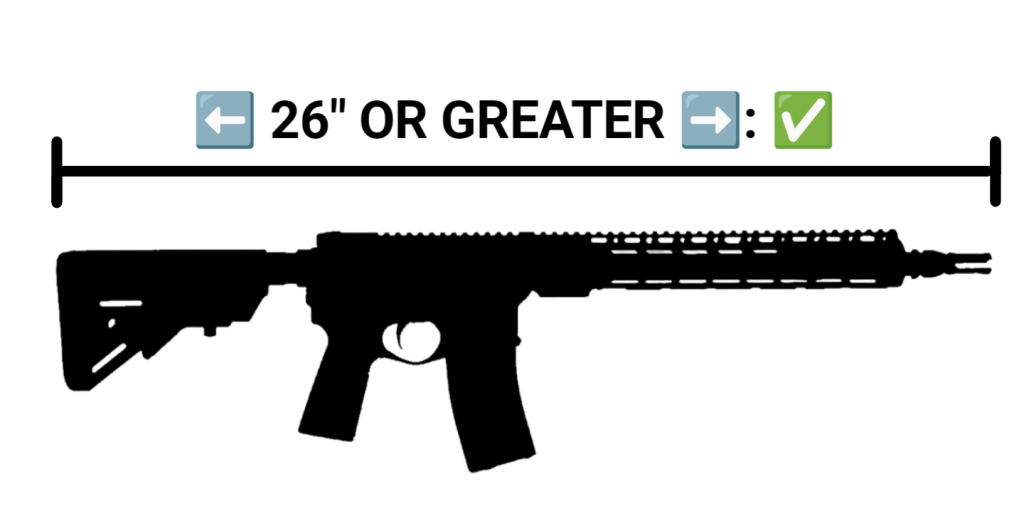
The handbook specifically states “???? ????? ????????” in this example:
“????: One version of the Marble’s Game Getter was produced with 18-inch barrels and a folding shoulder stock. This model of the Game Getter, as manufactured, is not subject to the provisions of the NFA because it has barrels that are 18 inches in length and the overall length of the firearm, ???? ????? ????????, is more than 26 inches.”
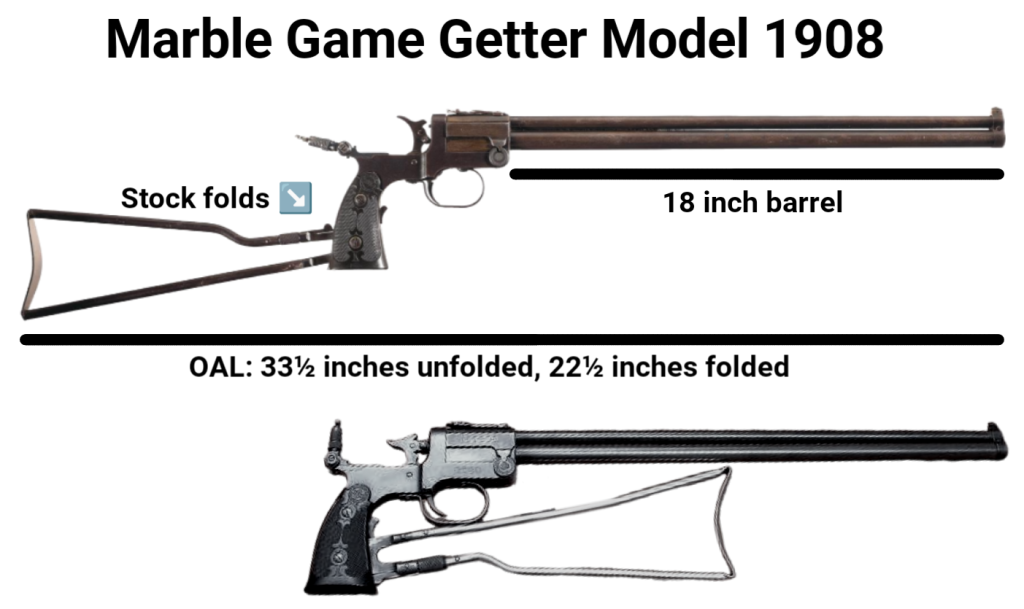
This is important, but first we’ll look at some other compliant examples. In addition to the NFA Handbook quotes, several factory rifles are available with an unfolded or collapsed length of less than 26 inches. For instance, Century Arms offers several factory folding rifles with an OAL less than 26″ when the stocks are folded. Each of them are sold as rifles and not listed as SBRs, as taken directly from the century arms catalog:
• RAS47 Magpul Zhukov Rifle: 25.5” folded, 37.25” extended

• N-PAP DF Rifle: 24” folded, 34.25” extended

• Centurion UC-9 Carbine: 24” folded, 31.5″ extended
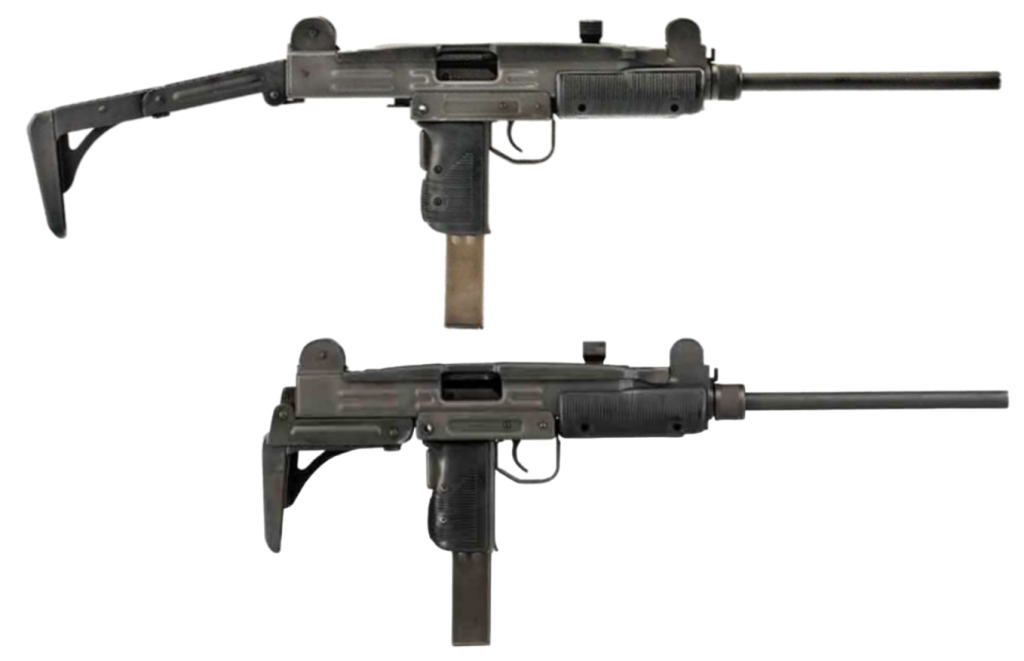
So why is this important? Because as Rifles, they are intended to be fired from the shoulder. Thus, their OAL measurements are taken with their stocks extended/unfolded as they’re intended to be fired. Therefore, if your rifle has a LAW FSA and a stock on it (even if it’s also equipped with the ARIC and could fire folded), the OAL measurement would only apply with the stock extended/unfolded BECAUSE THE STOCK MAKES IT A RIFLE, which means it’s intended to be fired from the shoulder. This can only be done with the stock unfolded.
Again, NOTHING about the LAW Folding Stock Adapter or the ARIC BCG along with it affect the OAL measurement, and they have never been subject to anything related to the status of pistol braces in the eyes of the NFA regulations.
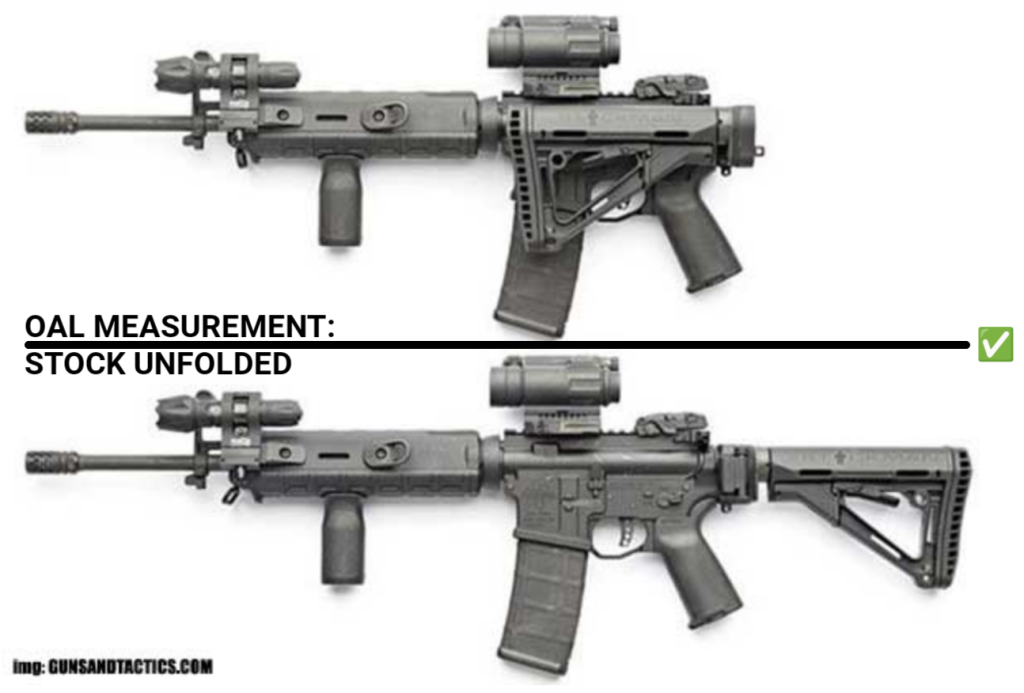
ACCESSORY TO…?
What about accessories relative to NFA status? This one’s pretty much common knowledge, but we’ll cover it again just to make sure.
VFGs (vertical fore grips):
• If OAL is ≥26″, AND there is no stock, they’re good to go ✅
• If OAL is less than 26″, DO NOT add the VFG as this will automatically turn your “Firearm” or “Pistol” into an “AOW,” even if there’s no stock attached to the weapon. It’s stupid but this is the world we live in. ❌
AFGs, Handstops, etc: These are good to go regardless of any other detail regarding OAL. Because they’re not considered VFGs, they don’t have the same “automatic SBR” attribute if you add them to your <26” OAL gun. ✅
GRAY AREA
So what about “Firearm,” the gray area between a “pistol” and a rifle that also has an OAL of 26″ or more? Well if it’s an AR and you’ve got an FSA attached, the receiver extension tube needs to be unfolded to fire the weapon. For things with wholly internal carriers like the SIG MCX SPEAR-LT or Brownells BRN-180, your OAL measurement would start at the muzzle and end at the rear of the lower receiver if it didn’t have a stock attached to it. Less than 26” OAL would make it a “Pistol” until you attach a stock; at that point it’s an SBR. If you add a VFG to a “Pistol”, it becomes an AOW(Any Other Weapon), which also requires a $200 tax stamp under the NFA.
The most noteworthy example of the “Firearm” loophole was the Franklin Armory XO-26b. An AR with an 11.5” barrel AND a VFG, but no stock, and no SBR tax stamp.
How? The OAL was 27.8 inches. Too long to be a “pistol,” but not considered a rifle (intended to be shoulder fired) since there was no stock. Just a “Firearm,” measured as described above to determine its OAL:
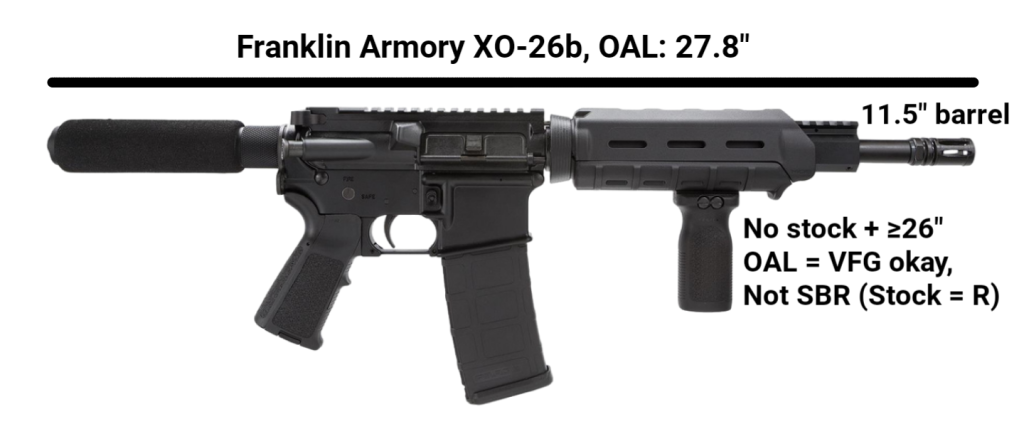
Note that if we are talking about a “Firearm” and not a “Rifle”, it does not have a stock and as such it is not intended to be fired from the shoulder. So the brace virtually goes away and doesn’t count toward OAL measurement. Also, the OAL is measured in the shortest configuration, so if you have a folding or collapsible buffer tube or brace, the OAL is measured folded or collapsed and not extended like a rifle. So make sure you’re still over 26″+ on your OAL by further increasing your barrel length if you’re trying to play the “Firearm” technicality game and have an FSA attached to the lower receiver.

FRONT TO BACK
So if you don’t want to go the NFA route, what are the shortest rifle setups you can have lawfully within legal limits without crossing into NFA territory? There are two ways you can go about it:
• In the front, with barrel length including a pinned muzzle device totaling 16+”
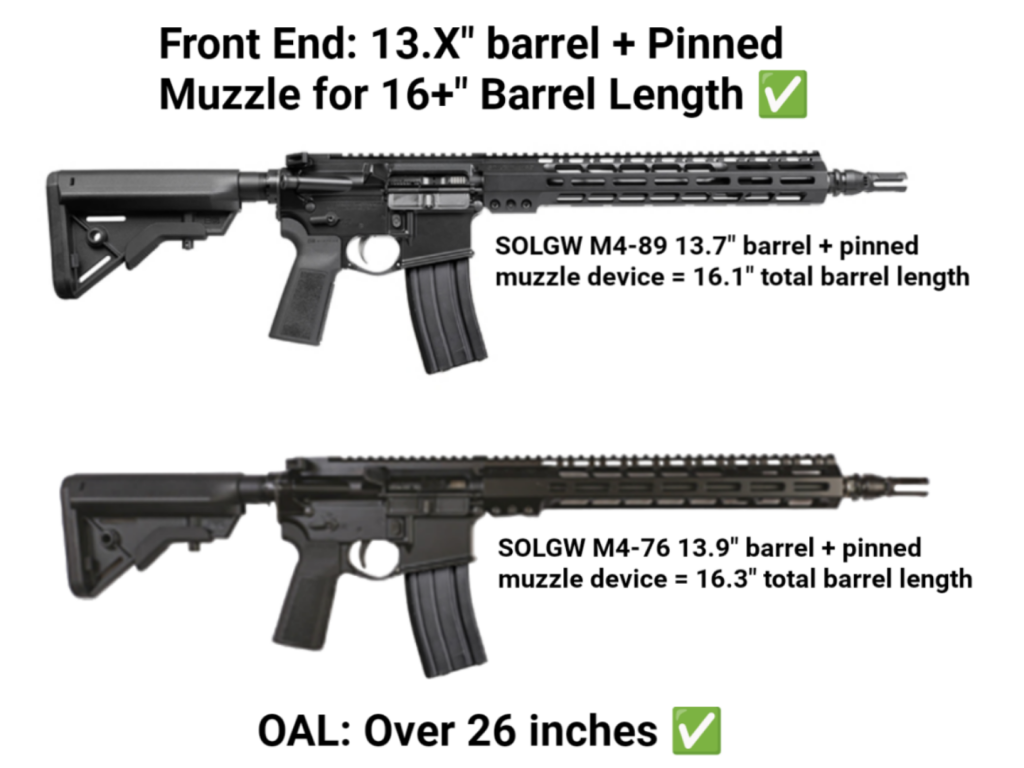
• In the back, with a longer receiver extension tube and therefore a shorter barrel, with or without a pinned muzzle device depending on barrel length
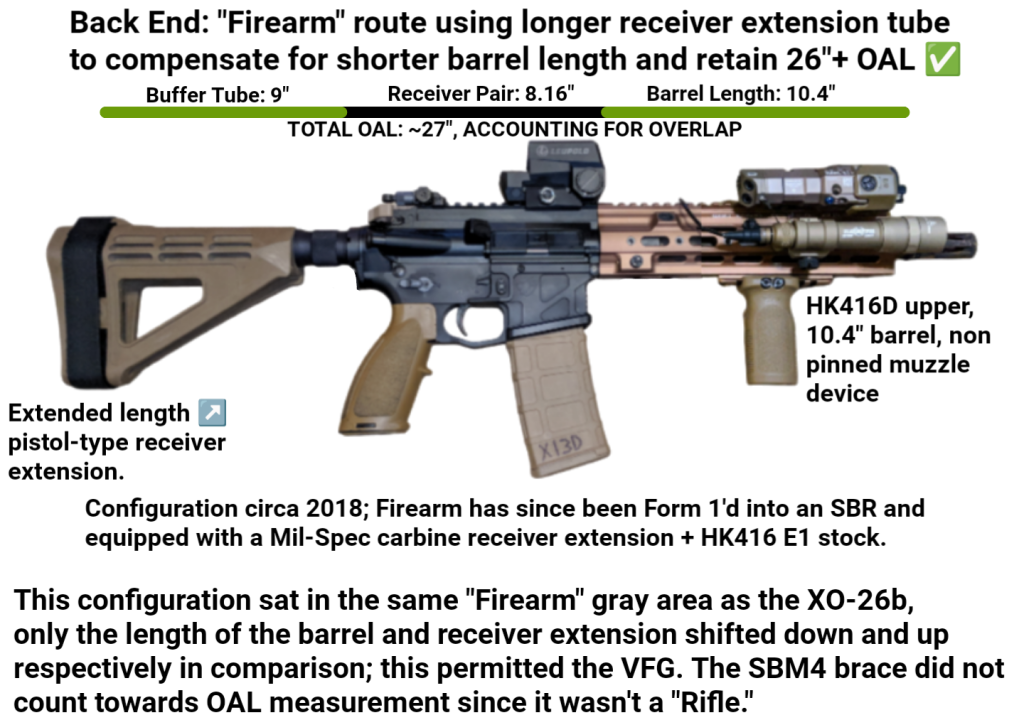
The 13.X” barrel trend (be it 13.7″ or 13.9″) came into vogue because, when paired with muzzle devices 2.6″ or greater in length that are permanently attached to the barrel, they’re considered 16″ or more. This combination therefore became the shortest barrel you could have while still rocking a normal stock without stepping into NFA territory.
The other way to do it, if your barrel is shorter than 13.7″, is to utilize a longer receiver extension or “buffer tube” on the back. Some of the “Pistol” style tubes that can’t mount a stock because they lack the track for the adjustment stop of the stock itself are longer than a standard carbine length tube (9-10” vs the standard 7.25”). Before I was able to Form 1 the lower my HK416 upper sat on and make it an official SBR, it had an extended tube on the back end.
If the muzzle device isn’t pinned to the barrel, the OAL measurement stops at the crown of the muzzle on the barrel itself. Between the end of the receiver extension tube and the muzzle of the 10.4″ barrel, I was just barely able to eke out an OAL of ~27″, over 26″ either way. This put me in the clear to utilize a VFG on the “Firearm.”
FSA, FOR YOUR CONSIDERATION
Like I’ve said a few times, not only did the FSA never contribute to anything regarding to the OAL stipulations relative to intended use, but it never affected or was touched by any of the back and forth pertaining to pistol braces either.
We also covered how the OAL was factored for an AR platform rifle: the receiver extension can’t fold, so the length between the muzzle and the end of the receiver extension is all you have with an AR platform weapon, necessary to its proper function and cycling.
We’ve also highlighted that the minute you delete the need for the receiver extension tube, you can no longer include its length in the OAL measurement. But the presence of the FSA, even in conjunction with an ARIC, doesn’t delete the need for the receiver extension or exclude it from the OAL measurement: just like the AKs from Century Arms mentioned above, just because it can fire with the stock folded doesn’t mean it’s not a rifle in the eyes of the law.
So when would the FSA or ARIC contribute to that and change things? Well, as it comes, the FSA wouldn’t. The ARIC though… let’s say one were to modify the FSA and take the hinged section that the receiver extension threads to off the adapter, leaving only the part that attaches to the lower receiver. Or if a purpose built variant of the FSA was developed that was railed on the back, or just blank all together for true “pistol” use. Using these in conjunction with the ARIC would change things:
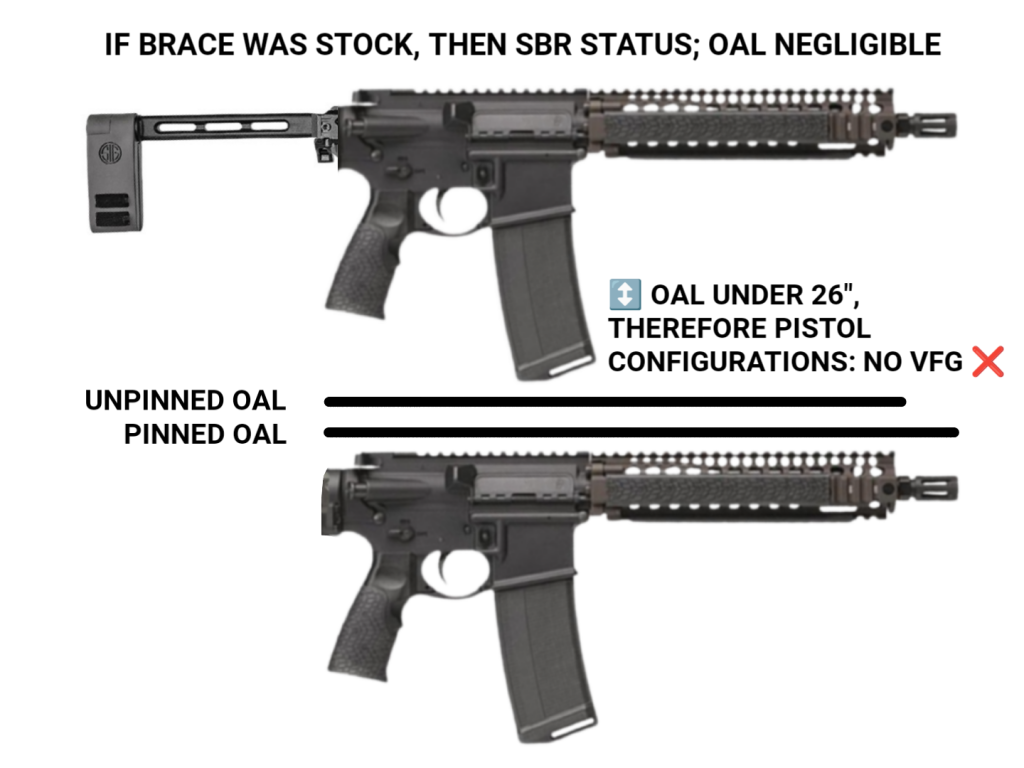
However, this is more of a trivial inclusion since no such ARIC adapters are offered by LAW Tactical. Not yet, anyway.
CONCLUSION
All of this is to illustrate your options in acquiring the shortest AR you can get without stepping into NFA territory, and to reassure you that the presence of the FSA alone or with the ARIC does not change your Rifle’s legal status or OAL measurement; all you’ve gotta pay attention to is the barrel length. Bear in mind, all of this information is based only on Federal/ATF information. LAW Tactical is aware that some states (such as California) take it a step further by measuring the overall length in the smallest or shortest configuration, overriding Federal and ATF precedent. YOU are responsible to know and understand the laws of your jurisdiction before installing any firearms components.
Stay Dangerous
Stay in this L.A.N.E.


